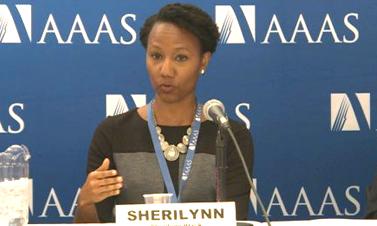
Several research universities are leveraging targeted programs and data analysis to improve the representation and achievement levels of minority, low-income and first-generation college students in science, technology, engineering and mathematics, according to three researchers who presented results at the 2017 AAAS Annual Meeting in Boston.
These students are often underrepresented in the STEM programs due to issues like imposter syndrome or a lack of role models, said Sherilynn Black, director of the Office of Biomedical Graduate Diversity and assistant professor of the practice in medical education at Duke University.
Such barriers, Black noted, can be rooted in and compounded by implicit bias: the cognitive illusions and errors that appear in the thinking of all human beings when our brains take unconscious shortcuts to deal with massive amounts of information, which can lead to snap judgments about the capabilities of underrepresented groups – like minority science students.
These shortcuts are part of everyone’s thinking, even members of those underrepresented groups, said Lydia Villa-Komaroff, a molecular biology researcher and diversity advocate based in Chestnut Hill, Mass. “All of us are subject to implicit bias that arises because of our evolution and cultural history,” Villa-Komaroff said.
To combat the effects of these perceptions, Duke University created the Office of Biomedical Graduate Diversity to broaden participation in the sciences and support underrepresented students through an array of programs, Black said.
“If an environment and a culture is created where they can be celebrated and we can all be aware of our own biases and ways to overcome them, students can be successful,” Black said.
Since the launch of the office, applications to biomedical science programs at Duke from underrepresented groups more than doubled, Black said, from about 50 or 60 students to 143 last year.
Yet their benchmarks are not just about application numbers. The office has also seen improvements in the achievements of underrepresented students, including increased rates of successful matriculation and more students receiving fellowships and funding, Black said.
Using data instead of gut reactions can help ameliorate the effects of bias, said Villa-Komaroff. At Georgia State University, where 80% of students are first-generation, low-income or members of underrepresented racial and ethnic groups, a data-driven program has boosted the number of STEM degrees conferred, according to Timothy Renick, vice provost and vice president for enrollment management at Georgia State.
Collecting data from the grades of 2.5 million students and 140,000 student records, Renick and Georgia State identified “academic mistakes” students make that are statistically correlated to dropping out or failing out of college. The team thought they would find several dozen mistakes, Renick said. Instead, they found 800 different problems, including underperforming in prerequisite courses or enrolling in the wrong course, which 2,000 students did last year, Renick said.
The Graduation and Progression Success program promotes early intervention by tracking the entire student body and immediately notifying a student’s adviser once any of the 800 risk factors emerge, Renick said. Previously, a student might fail a course before their adviser knows they are having trouble. Now, the GPS program involves the student’s adviser almost immediately, he noted.
“If you’re driving and you go off course, and you catch it very quickly, it’s much easier to get back on-course again,” Renick said. “If students get off-path, if they begin to make mistakes and we correct those mistakes early, they’re much more likely to be righted.”
While the program tracks all students, regardless of demographics, GPS has been particularly beneficial for underrepresented groups, such as first-generation college students, who are often hampered by “lack of institutional know-how,” said Renick. In the last four years, the number of students graduating from Georgia State has increased by 30%, with even more dramatic growth among minority students in STEM, Renick said. The number of STEM degrees conferred to black men is up more than 100% and more than 200% in STEM degrees to Latino and Latina students, he said.
The use of data is important not just for reaching students. It also helps science-minded faculty members who must be aware of issues facing underrepresented students understand that implicit bias affects them, too, Villa-Komaroff said.
Susceptibility to bias does not mean we are bad people, Black said. “What it means is that we are working as a community to overcome a bias that’s implicit in all of us.”
Original story at: http://www.aaas.org/news/programs-combat-bias-boost-stem-success-targeted-students